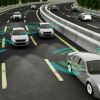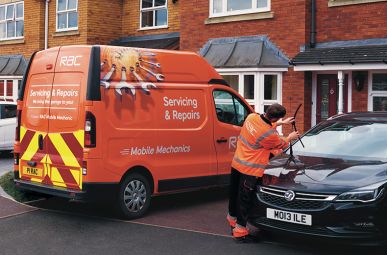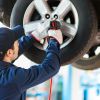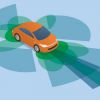Safety on the streets is important for drivers, pedestrians, and all other road users. And ABS has been one of the most valuable developments in new car safety.
Knowing how your ABS works is vital for learners and experienced drivers, and this guide will give you all the information you need.
What are anti-lock brakes?
Anti-Lock Brake systems, also known as ABS, are a safety feature found in most modern cars.
They are designed to prevent the wheels from locking up when the driver applies the brakes too hard or too suddenly.
By stopping the wheels from locking up, the car is able to maintain stability and control even when braking at high speeds.
The ABS system works by using sensors located near each wheel to detect when the wheel is rotating too quickly. When this happens, the electronic ABS system will automatically apply and release the brakes in a very fast, yet controlled manner.
This then allows the driver to maintain control of the vehicle.
This is especially useful when braking on wet or icy roads, where the car is more likely to skid on the road surface.
With the help of ABS, drivers can avoid skidding and loss of control, helping to keep them safe on the road.
What do they do?
Anti-lock brakes work by monitoring the speed of each wheel and adjusting the brake pressure applied to each wheel individually.
When the driver applies the brakes, the ABS system uses a series of sensors to detect the speed of each wheel. If one wheel begins to slow down faster than the others, it means that the wheel is beginning to lock up, meaning the car is losing traction.
The ABS system then modulates the brake pressure, reducing the pressure on the locking wheel and allowing it to regain traction. This process is repeated for each wheel until the car comes to a stop.
Without ABS, the brakes could lock up and cause the car to skid and spin out of control. This is especially the case when driving in heavy rain and flooded roads.
How are they different to regular brakes?
Anti-lock and regular brakes are two types of braking systems used in all types of vehicles.
Both use brake callipers, or clamps, to stop the vehicle by applying pressure on the wheels. The main difference between them is the way in which they work.
ABS is a computer-controlled system that monitors wheel speed and applies and releases pressure to the brakes as needed. This helps to prevent wheel lock-up and skidding, which can happen when a driver applies too much pressure to the brakes. ABS also helps to provide better control over the vehicle, as it can allow the driver to steer the car during braking.
Regular brakes are a simpler system that relies on the driver to apply the correct amount of pressure themselves to the brakes.
When the brakes are applied, the callipers press against the wheel and cause it to slow down. If too much pressure is applied, the wheels can lock up, causing the car to skid and lose control.
Is ABS better or worse than traditional brakes?
Overall, ABS is a more advanced braking system that can provide better control and safety in vehicles.
It is also more expensive and requires more maintenance, as the computer system must be regularly checked and calibrated.
Regular brakes are a cheaper and simpler system, but they can be less safe if the driver does not apply the correct amount of pressure.
How to use anti-lock brakes
Simply, when you apply the brakes with your right foot, the ABS will engage.
It is the driver’s responsibility to be safe on the roads, and by firmly applying the brakes, the ABS will adjust the braking pressure automatically. Many drivers mistakenly press the brake pedal too lightly, which can cause the ABS to engage when it shouldn’t.
You will likely feel a pulsing in your foot as it slows the vehicle down. Do not pump the brakes – as this can cause more issues.
Keep your hands on the wheel, and only change gears or use an in-car feature if safe to do so.
How do they go wrong and what's the danger?
Anti-lock brakes are designed to prevent a vehicle from skidding when braking. However, just like any other vehicle system, ABS can fail or malfunction leading to several issues.
One common problem with ABS is when the brakes lose their sensitivity. This can happen when the brake system is contaminated with dirt, oil, or moisture. It can also occur if the brake pads are worn down. When this happens, the brakes will not be as responsive as they should be, making it difficult to stop the vehicle in a timely manner.
Getting your car serviced is an easy way to stay on top of this, and should be carried out at least once a year, or every 12,000 miles – whichever comes first.
Another issue that can occur is when the ABS system fails to activate when needed. If the ABS system is not properly calibrated, it can fail to kick in when the brakes are applied. This can lead to a delayed reaction, which can be dangerous – especially if the vehicle is going at high speeds.
Finally, ABS systems can also become stuck in the ‘on’ position. This can cause the brakes to become overly sensitive and cause them to lock up when the brakes are applied.
If this happen, then it can lead to an unexpected and sudden stop, which can be dangerous for the driver and other vehicles on the road.
Drivers should be aware of the potential problems and take the necessary steps to keep their ABS systems in good condition.
If you are unsure, or want an expert to check, call a mobile mechanic or visit a local garage to make sure your brakes are in good condition.
Service, repair or MOT?
You can trust the RAC with our local approved garages and NEW mobile mechanics.
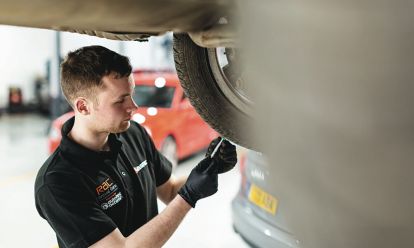

What should you do if your anti-lock brakes (ABS) warning light stays on?

Your car dashboard warning lights are important in keeping your car in the best condition possible and to also make sure yourself and all road users are safe.
If your ABS warning light stays on, it is important to act immediately. This warning light indicates that something is wrong with the system, and it needs to be addressed.
The first step is to check the brake fluid level. If it is low, you will need to add more.
If the brake fluid level is full, then you will need to have the ABS system checked by a professional mechanic. They will then need to diagnose the issue and repair any faulty components.
The best course of action is to stop immediately and call a mechanic, but if it is safe to do so, get to a garage and they can have a look at it.
Common problems that can cause an ABS warning light to stay on include a faulty sensor, worn brake pads, or a faulty control module. It is important that any faulty components are replaced to ensure that your vehicle's brakes are working properly and safely.
Once the technician has diagnosed and repaired the issue, the ABS warning light should turn off. If it does not, then they may need to look further into the issue.
What type of road surface may anti-lock brakes not work effectively?
ABS may not be effective on surfaces that are covered in gravel, uneven, damaged, or after it has snowed. Also, a common issue for all types of braking systems is how they cope when the road surface is covered in ice.
These road surfaces lack the grip necessary for the brakes to be effective, which can cause the wheels to lock up and prevent the vehicle from stopping. Therefore, it is important to always drive at a safe speed and maintain a proper distance from other vehicles when driving on these types of surfaces.
The best road conditions for ABS are where there is solid contact between the four tyres and the road.
Maintaining your brakes
Your brakes are arguably the most important safety feature on a vehicle, so it’s important to make sure they’re consistently in good working order.
To do this, it’s important to follow a few simple tips:
- Inspect your brakes regularly. It’s important to inspect your brakes every 6 to 12 months; this allows you to detect and fix any problems before they become more serious. During the brake inspection, the mechanic will check for worn brake pads, fluid leaks, and any other signs of wear or damage.
- Follow the manufacturer’s recommendations. The manufacturer of your vehicle knows the best way to maintain your brakes, so it’s important to follow their maintenance guidelines. This usually means changing your brake fluid, pads, and rotors every 30,000 to 50,000 miles depending on the type of car you have and the driving conditions. Maintaining your vehicle is important in extending its life and keeping you safe.
- Listen for warning signs. If your brakes start to make any strange noises, such as squealing or grinding, it’s important to get them inspected right away. This noise is usually a sign that the brake pads are worn, and need to be replaced.
- Test your brakes regularly. It’s important to do this to make sure they’re functioning correctly. This can be done by simply pressing the brake pedal to make sure it’s firm, and that the car stops quickly and smoothly.
Always consult your car manufacturer’s guide that comes with your vehicle, as it will let you know when you should service or replace any part of your vehicle.
If you are unsure, take your vehicle to a local garage to give you peace of mind that your car is in the best condition possible.
What is Autonomous Emergency Braking?
Autonomous Emergency Braking (AEB) is an advanced safety feature found on many modern cars. It is designed to reduce the severity of a collision or even prevent one altogether.
It works by sensing when a potential collision is about to happen and automatically applying the brakes.
AEB uses sensors such as cameras, radar, and lasers to detect when an object is in the car’s path.
When it detects a potential collision, it will first provide an audible and visual warning to the driver, then if the driver does not respond in time, it will apply the brakes automatically.
AEB is a great tool for improving safety on the roads and reducing the severity of collisions. It is becoming increasingly commonplace in new cars as more manufacturers include it as a standard feature.
Need your brakes repaired?
RAC Mobile Mechanics offer maximum convenience and can replace your brakes on your doorstep.


ABS – your driving test
Almost all modern vehicles are fitted with an anti-lock braking system – and it will be a part of your driving theory test.
You will be asked several questions
If you are practicing and learning to drive, you can take a free driving theory mock test on the Government’s official website.
As for apps, Driving Theory Test UK is a great place to start, with all necessary learning materials, hazard perception clips and Highway Code info included. You can download it here.
Good luck in your driving test!
Does ABS help in the snow?
Anti-lock braking can be beneficial when driving in snowy or icy conditions, but its effectiveness depends on how it is used by the driver.
ABS prevents the wheels from locking up during braking, which can help maintain steering control. When a wheel locks up on a slippery surface, it loses grip with the surface of the road, which can lead to a loss of control. ABS rapidly pulses the brakes to prevent this, allowing drivers to steer while braking.
So, when it comes to using ABS effectively in the snow, it allows a driver to steer while braking, which can help you avoid obstacles, vehicles, and other road users.
However, ABS can sometimes increase stopping distances because the system prevents the wheels from locking, which might help the tyres dig into the snow and surface of the road for more grip.
If driving on soft, loose snow, gentle braking and steering can bring the car to a stop more quickly than an emergency stop with ABS.
This is why drivers should not be driving too fast and be overconfident with the ABS technology – driving aggressively will likely result in a collision.
Remember, the softer the surface, the softer a driver should apply the brake.
ABS won't be able to prevent a crash in the snow, it is still down to the driver and how they conduct themselves behind the wheel.
Drivers should always reduce their speed, increasing following distances of other road users, and adhere to correct tyre maintenance practices.
Book a car service today
It’s easy to book a service online at one of our local approved garages. Find a trusted local garage with the RAC stamp of approval.







